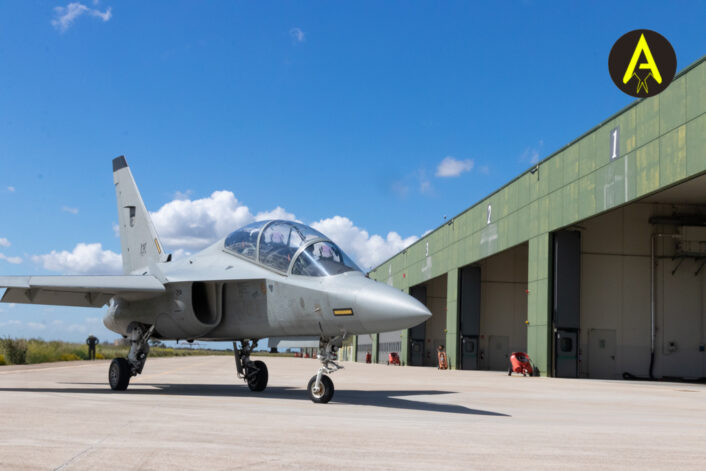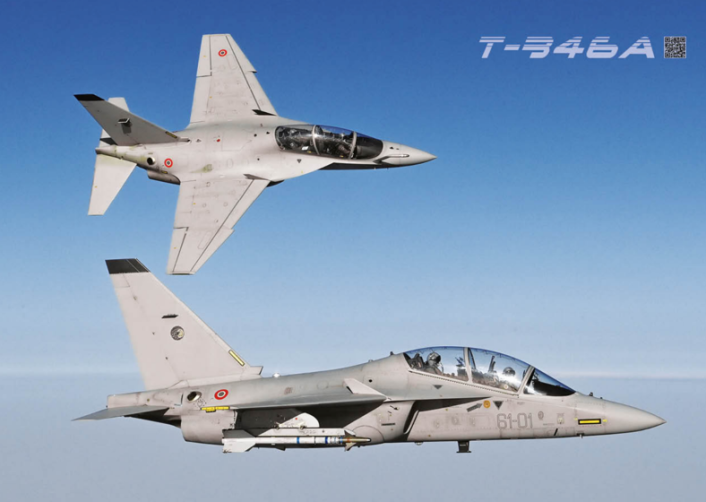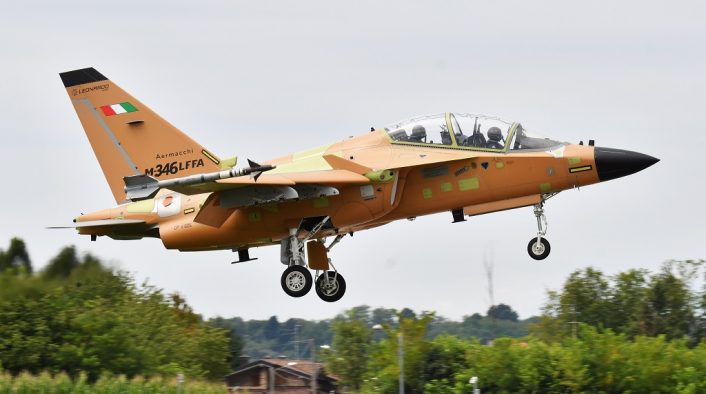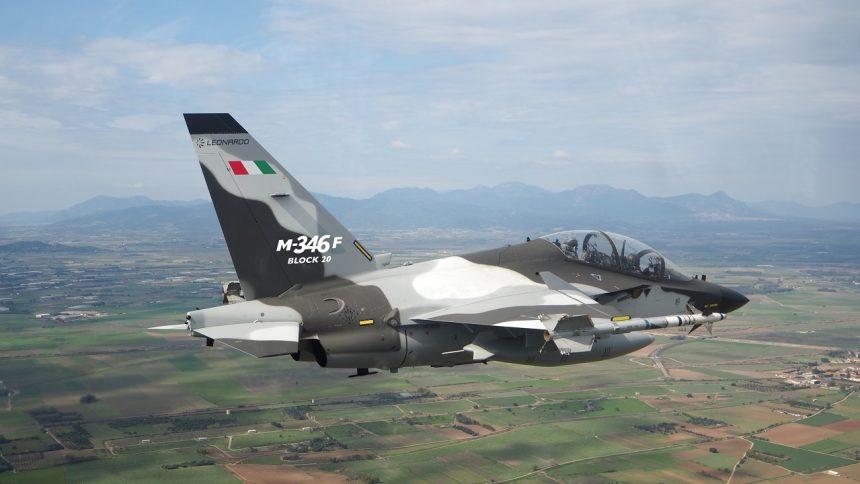Austria plans to acquire new trainers to replace the Saab 105 retired in 2020, and the military is in talks with Italy to explore the possibility of a joint purchase of the M-346.
Austria is considering a joint purchase of M-346 jet trainers with Italy, according to the Austrian Defense Minister Klaudia Tanner. The Italian-made aircraft would replace the Saab 105 fleet that Austria retired in 2020. Earlier in July, the chief of the Austrian Air Force said that the decision for a new trainer was to be expected soon.
The Saab 105s were retired after 50 years of service, leaving a gap in the pilot training capabilities. To address the problem, Austria joined the International Flight Training School, which also employs the M-346.
According to the reports, the Defense Minister launched a legal review for a potential partnership and instructed the military to start the talks with Italy. She also mentioned that such partnership was first proposed by Italy.
Tanner highlighted that that no final decision on the aircraft type has been made, as the L-39NG and T-7 were also being considered. The acquisition of the M-346 would have some benefits such as the existing familiarity of Austrian pilots with the type and shared training.
Reports also mentioned that Austria is looking to an aircraft which could be employed not only for training, but also for air surveillance and defense, complementing the Eurofighters. In fact, Austria is reportedly looking specifically at the M-346FA variant, the armed variant which is also equipped with a radar.

Not the first joint deal
In the past, Austria also collaborated with other countries for military acquisitions. For an instance, in 2021 Austria and Italy agreed on a government-to-government deal for the acquisition of the AW169M helicopter to replace the Alouette III.
One of the reasons behind the deal was reported to be the Federal Ministry of Defence interest in a partner which would be willing to fully cooperate with the Austrian Armed Forces in all areas of the operation of military helicopters, in order to be able to work cost-effectively over the entire life cycle.
In December 2022, the Austrian Ministry of Defense took delivery of its first AW169M with skid undercarriage and later exercised options for an additional 18 helicopters, bringing to 36 the total number of AW169M Light Utility Helicopters. This also represents the first export deal of the type.
The AW169M will carry out a wide range of missions supporting Austrian defense requirements and the population, such as troop transport, combat operations, disaster relief and emergency response, fire-fighting, mountain rescue and MEDEVAC.
Similarly, during the Farnborough Airshow in July 2024, Austria and the Netherlands signed for a joint procurement of nine Embraer C-390 transport aircraft. Specifically, the Netherlands will get five aircraft, while Austria will get the other four. Austria will use these aircraft to replace its older C-130Ks, which were bought second-hand from the Royal Air Force.
The deliveries will be alternated between the two countries, starting in 2027. The aircraft will be in a similar configuration, although the Austrian ones will not have the capability to refuel other aircraft and its air refueling capability will be limited to being a receiver only.

The M-346
The M-346 Master celebrated this year the 20th anniversary since its first flight. The aircraft, considered by many as the most advanced jet trainer currently available, brought many new technologies to improve the training of future 4th and 5th gen fighter pilots, including the state-of-the-art Ground-Based Training System and the Live Virtual and Constructive (LVC) technologies.
As we often mentioned, the M-346 Advanced Jet Trainer revolutionized the training world. In fact, we are not just talking about an aircraft like in the past, but about a fully Integrated Training System which includes both the aircraft and an advanced Ground Based Training System that complements the capabilities of the aircraft and makes the training more efficient.
The GBTS, a fundamental part of the training system, is one of the most complete ever produced, and is composed by the Computer Based Training and a network of simulators which comprises Simulation Based Training, Partial Task Trainer, Full Mission Simulator. The other ground devices are the Real Time Monitoring Station and the Mission Planning and Debriefing Station.
The GBTS allows pilots to learn formation flight, basic maneuvers, advanced combat tactics, both day and night, without the need to get wheels off the ground. This allows a reduction of the flight hours required to compete the training of future fighter pilots of the latest generation aircraft, lowering the costs and improving the efficiency and availability of the fleet for operational tasks.
While the cost reduction is important, the M-346 ITS is unique because it allows the creation of the Live Virtual Constructive environment, an integrated training environment where the real and virtual worlds merge into a single operational scenario in which pilots in the simulators can interact with pilots flying on the real aircraft. This way, future Eurofighter and F-35 pilots can operate simultaneously real flights (live), simulators (virtual), and add at the same time different types of computer-generated threats (Constructive).
The T-346s also have an integrated onboard Embedded Tactical Training System (ETTS), which allows the simulation of sensors, weapons, simulated forces so that pilots can interact in real time with a tactical virtual scenery. Among these, we find advanced simulations of radar, datalinks, targeting pods and all kind of sensors used on modern fighters.
In addition to its training variant, Leonardo has developed a combat-capable version of the aircraft called the M-346 FA (Fighter Attack), also known as Light Fighter Family of Aircraft (LFFA). The most visible differences from the standard AJT configuration are the two wingtip missile rails, that bring the total hardpoints to seven, new antennas and the Defensive Aid Sub System (DASS).

The M-346FA variant is designed to retain the full dual role capability of the AJT version, already in service with the Italian, Israeli, Polish and Singapore Air Forces, while incorporating also some new features like a tactical data link, Grifo-346 mechanical scan, multi-mode radar, new secure radios and IFF system (Identification Friend or Foe), and a stronger airframe.
The aircraft, which is being proposed for Homeland Defence/Air Policing, Slow Mover Intercept, Close Air Support (CAS), Counter INsurgency (COIN), Forward Air Controller – Airborne (FAC-A), Combat Search And Rescue (CSAR), Interdiction, Battlefield Air Interdiction (BAI), Tactical Air Support for Maritime Operations (TASMO) and Tactical Reconnaissance roles, can carry more than 2,000 kg of weapons.
Leonardo announced at the 2024 Farnborough International Air Show the launch of a comprehensive capability enhancement package for the M-346. This major upgrade comes as the M-346 fleet surpassed 100,000 flight hours as well as ten years of service.
Both M-346 AJT (Advanced Jet Trainer) training and M-346 LFFA (Light Fighter Family of Aircraft) fighter variants will benefit from these enhancements for a wide spectrum of applications, while implying significant margin for further developments in the future. Leonardo said that ‘M-346 T Block 20’ and ‘M-346 F Block 20’ are the designations for the new standard of both aircraft.
The Block 20 standard cockpit will be completely renewed, featuring two Large Area Displays (LAD), one per each seat, replacing the existing six Multi-Functional Displays (MFD), plus a low-profile Head-Up Display (HUD). These will be combined with a new digital video and data recorder and a new augmented reality Helmet Mounted Display (HMD).
The M-346 Block 20 will also benefit from new navigation, weapon management, flight management system, IFF (Identification of Friend or Foe) transponder. Specifically for the M-346 F variant, further critical capability enhancements include an AESA (Active Electronically Scanned Array) radar featuring fire control radar capability, integration of new weapons for both air-to-air and air-to-ground roles in addition to a built-in missile datalink.
Leonardo said the new Block 20 standard will not be limited to the platform itself, but rather to the entire system including the ground-based training system. Interestingly, the company also added that the work shall be enabled by the widespread implementation of digitalization powered by AI.









